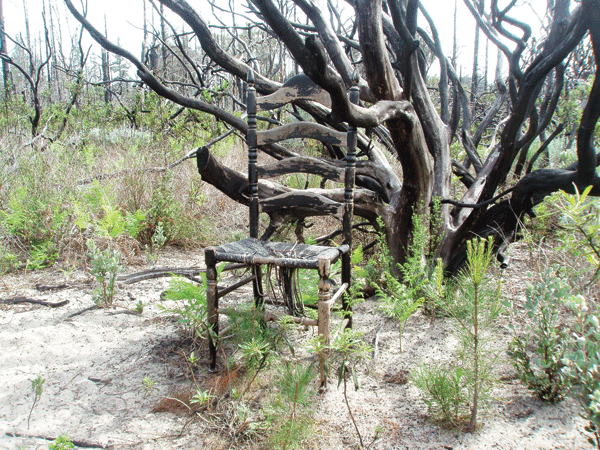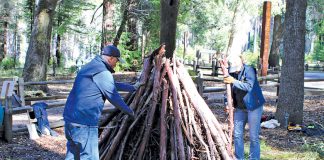
I walk regularly in Henry Cowell State Park in Felton. I can’t imagine losing the majestic redwood forest I enjoy so much to a fire. Over the summer there were a number of arson-caused fires in the park. Actually 10 separate fires have occurred in the same general area and along the San Lorenzo River over the past six months, some caused by campfire escapes and some by arson. All of them were caused by humans.
We live in this beautiful area because of the natural scenery and wildlife. To lose any part of it to wildfire would be tragic. Whether a fire is caused by humans or natural causes such as lightning it’s all the same to our neighborhood, our homes, our pets, our lives.
We know that fire in some instances can be good for the land. After many years of fire exclusion an ecosystem that needs periodic fire to remain healthy becomes overcrowded and flammable fuels build up. The Forest Service manages prescribed fires to benefit natural resources and protect communities. However, as we build homes further into nature, prescribed fires are not always possible. This is where mechanical treatment can benefit ecosystems and people.
Mechanical treatment includes thinning of dense stands of trees or other fuels to make an area better able to withstand fire. Pruning looser branches, piling brush or creating fuel breaks encourage a more manageable fire should one occur.
Last week I talked about how to make the area closer to your home more firesafe. Here are some more tips.
In areas 30 to 70 feet away from your house, plants should be trimmed and thinned to create well-spaced groups and help prevent a fire in the wildland from spreading to your home.
Be cautious with slopes. If you have a large lot, the fringe area should be inspected and maintained regularly to eliminate any build-up of dry brush and litter. This reduces the chance of surface and crown fires.
Plant arrangements, spacing and maintenance are often as important as plant types when considering fire safety. Group plants of similar heights and water requirements to create a landscape mosaic that can slow the spread of fire and use water most efficiently. Use plants that no not accumulate dead leaves or twigs. Keep your landscape healthy and clean.
On a regular basis remove dead branches and brush, dry grass, dead leaves and pine needles from your yard, especially within 30 feet of your home and at least 150 feet if you’re on a hill. Keep trees spaced at least 10 feet apart with branches trimmed at least 10 feet away from your roof. It’s best, however, to keep trees further from your house. Low shrubs can be closer in and herbaceous perennials and groundcovers can be nearest the home.
Extremely flammable plants have a high content of oil or resin and should be separated from each other, removed of dead branches and lower limbs, and kept free of dry debris anywhere around your property.
Extremely flammable plants like hollywood juniper, pines, fountain grass and Japanese honeysuckle need a higher level of maintenance.
Other common plants that are highly flammable are sagebrush, buckwheat and deer grass. Rosemary and purple hopseed also fall into this category. These contain oils, resins and waxes that make them burn with a greater intensity. If you have these plants on your property yearly pruning and maintenance is important.
Irrigation is vital in a fire-safe landscape to maintain plant moisture, especially in the 30 feet around your home. Choose the right irrigation system.
While all plants can eventually burn, healthy plants burn less quickly. Consider drip irrigation and micro sprays for watering most of your landscape. Use sprinklers for lawns and other groundcovers or turf. Even drought-adapted species and natives will benefit from watering every month or so during the dry season. Unwatered landscapes generally increase the risk of fire.
Mulching around your plants will preserve water in these times of drought. Plantings beyond 30 feet should be irrigated occasionally, but to a lesser extent. As you get 70 to 100 feet from the home, native plantings that require little or no irrigation should be used.
Using fire resistant plants that are strategically planted give firefighters a chance fighting a fire around your home especially within the 100 foot defensible zone. Each home or property is different and you will need to look at the unique qualities of yours in planning your firescaping. Some of the info for this column was obtained from two valuable booklets. The first, “Living with Fire in Santa Cruz County” is prepared by Cal Fire and available free from any fire department or online. The other is from the California Department of Forestry at www.fire.ca.gov.
– Jan Nelson, a landscape designer and California certified nursery professional, will answer questions about gardening in the Santa Cruz Mountains. E-mail her at ja******@*ol.com, or visit www.jannelsonlandscapedesign.com to view past columns and pictures.










